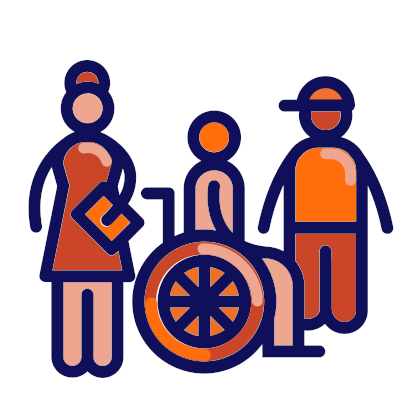Improving well-being at school

Since well-being has many facets, improving students’ well-being in schools requires a whole-school approach, involving both teachers and parents.
Schools should provide lessons focused on the responsible use of the Internet, the need to adopt a healthy lifestyle and how to prevent or cope with health problems, in collaboration with those involved, including health and social services, local authorities and civil society organisations.
Facts & figures
About 60% of school students report getting very tense when they study.[1]
Just over 60% of girls and 40% boys say they feel very anxious about doing tests at school, even when they are well prepared.[2]
Over 70% of parents say they would choose to send their children to a school with below-average exam results if students were happy there.[3]
What is well-being?
Well-being is the experience of health and happiness. It includes mental and physical health, physical and emotional safety, and a feeling of belonging, sense of purpose, achievement and success.
Well-being is a broad concept and covers a range of psychological and physical abilities. Five major types of well-being are said to be:
- Emotional well-being – the ability to be resilient, manage one’s emotions and generate emotions that lead to good feelings
- Physical well-being – the ability to improve the functioning of one’s body through healthy eating and good exercise habits
- Social well-being – the ability to communicate, develop meaningful relationships with others and create one’s own emotional support network
- Workplace well-being – the ability to pursue one’s own interests, beliefs and values in order to gain meaning and happiness in life and professional enrichment
- Societal well-being – the ability to participate in an active community or culture.
Overall well-being depends on all these types of functioning to an extent.[4]
“Having meaning and purpose is integral to people’s sense of well-being. Well-being involves far more than happiness, and accomplishments go far beyond test success.”[5]
Why is well-being important at school?
Well-being is important at school because schools have an essential role to play in supporting students to make healthy lifestyle choices and understand the effects of their choices on their health and well-being. Childhood and adolescence is a critical period in the development of long-term attitudes towards personal well-being and lifestyle choices. The social and emotional skills, knowledge and behaviours that young people learn in the classroom help them build resilience and set the pattern for how they will manage their physical and mental health throughout their lives.
Schools are able to provide students with reliable information and deepen their understanding of the choices they face. They are also able to provide students with the intellectual skills required to reflect critically on these choices and on the influences that society brings to bear on them, including through peer pressure, advertising, social media and family and cultural values.
There is a direct link between well-being and academic achievement and vice versa, i.e. well-being is a crucial prerequisite for achievement and achievement is essential for well-being. Physical activity is associated with improved learning and the ability to concentrate. Strong, supportive relationships provide students with the emotional resources to step out of their intellectual ‘comfort zone’ and explore new ideas and ways of thinking, which is fundamental to educational achievement.
Well-being is also important for developing important democratic competences. Positive emotions are associated with the development of flexibility and adaptability, openness to other cultures and beliefs, self-efficacy and tolerance of ambiguity, all of which lie at the heart of the Council of Europe Reference Framework of Competences for Democratic Culture.
What are the challenges?
One of the challenges of trying to promote young people’s well-being in school is the multi-faceted nature of well-being. There are a number of different types of well-being, all of which need to be promoted to some extent to create an overall sense of well-being in a person. So, it is not possible to improve students’ well-being at school through single interventions or activities. Rather it requires the development of a ‘culture’ of well-being throughout the whole school and the active involvement of the whole staff, teaching and non-teaching, which can be difficult to achieve.
The promotion of well-being may sometimes appear to conflict with other school priorities, such as academic standards. Unreasonably high expectations, a regime of constant testing or an over-emphasis on the importance of academic performance may actually undermine student well-being.
In many cases schools do not have the freedom to make the changes to school life which might most benefit student well-being. They may have little control, for example, over formal examinations and tests, the content of curricula, the length of the school day or the physical school environment.
Nor have schools control over the many out-of-school influences on student well-being. What happens in the home and the family, local communities or social media can have as much, if not more, influence on student well-being as anything in school.
Finally, developing a sense of well-being in students is made all the more difficult when school staff themselves do not have a positive sense of well-being. Well-being at work is strongly related to stress. Stress at work is related to workload, quality of professional relationships, level of autonomy, clarity about one’s role, availability of support and the opportunity to be involved in changes which affect one’s professional life. High levels of stress can lead to demotivation, lack of job satisfaction and poor physical and mental health, which has a knock-on effect on students’ own well-being.
How can schools get active?
Addressing student well-being at school begins with helping students feel they are each known and valued as an individual in her or his own right, and that school life has a meaning and purpose for them. This can be achieved in a variety of small ways, the cumulative effect of which can have a very powerful influence on students’ sense of well-being. These include:
- providing opportunities for all members of the school community to participate in meaningful decision-making in school, e.g. through consultations, opinion surveys, referenda, electing class representatives, student parliaments, focus groups, in-class feedback on learning activities, and an element of student choice in relation to topics taught and teaching methods used;
- developing a welcoming environment where everyone at school can feel supported and safe through access to meaningful activities, e.g. clubs, societies, interest groups and associations dealing with issues of concern to young people, including health;
- taking steps to reduce the anxiety students feel about examinations and testing through the introduction of less stressful forms of assessment, e.g. formative assessment, peer assessment and involving students in the identification of their own assessment needs;
- using teaching methods that contribute to a positive classroom climate and well-being, e.g. cooperative learning, student-centred methods, self-organised time, outdoor activities;
- finding curriculum opportunities to talk about well-being issues with students, e.g. healthy eating, exercise, substance abuse, positive relationships;
- integrating democratic citizenship and education for intercultural understanding into different school subjects and extra-curricular activities, e.g. openness to other cultures in Religious Education, knowledge and critical understanding of human rights in Social Science, empathy in Literature;
- introducing student-led forms of conflict management and approaches to bullying and harassment, e.g. peer mediation, restorative justice;
- improving the physical environment of the school to make it more student-friendly, e.g. new furniture and fittings, carpeted areas, appropriate colour schemes, safe toilet areas, recreational areas;
- encouraging healthier eating by providing healthy options in the school canteen, e.g. avoiding high amounts of sugar, saturated fats and salt;
- working with parents to enhance students’ achievement and sense of purpose in school, e.g. on healthy food, safe internet use and home-school communications.
Individual initiatives like these can be brought together at the whole-school level through a policy development process which ‘mainstreams’ well-being as a school issue. This means giving attention to the potential effects of new policies on individual well-being - of students, teachers and others. Addressing student well-being at school always goes hand in hand with action to protect the health and well-being of teachers and other staff at school.
[1] OECD (2017). PISA 2015 Results (Volume III), p.40. Students’ Well-Being. Paris, France: OECD Publishing.
[3] Cowburn & Blow, ‘Wise up - Prioritising wellbeing in schools’
[4] Psychology Today, January 2019.
[5] Hargreaves & Shirley (2018), ‘Well-being and Success. Opposites that need to attract’.
 Resources on Improving well-being at school
Resources on Improving well-being at school
 Related schools projects
Related schools projects
Address:
Country: Cyprus
Project: Passengers on the Same Bus! No Discrimination, Segregation and Inequality!
 Working language during the project:
Working language during the project:
- English
 Themes of the Council of Europe campaign “FREE to SPEAK, SAFE to LEARN - Democratic Schools for All” covered:
Themes of the Council of Europe campaign “FREE to SPEAK, SAFE to LEARN - Democratic Schools for All” covered:
- Making children’s and students’ voices heard
- Preventing violence and bullying
- Tackling discrimination
- Improving well-being at school
 Competences from the Reference Framework of Competences for Democratic Culture (CDC) addressed and where / how they were integrated:
Competences from the Reference Framework of Competences for Democratic Culture (CDC) addressed and where / how they were integrated:
- Valuing Cultural Diversity
An introduction to the issues of Diversity through:
- 1. Workshop: “Race of Life” A role-play
- 3. Workshop: “My pot: different and unique”
- Activity C2: Diversity unites us, it does not separate us!
- Activity C3: Lets uproot bullying - Openness to Cultural otherness and to other beliefs, world views and practices
- Sociology course connected with games against discrimination
- A campaign against discrimination - Respect
Workshop: “We are all Unique”
Activity C4: “I am a refugee- a migrant - Not a Criminal.
 Target group age range:
Target group age range:
- 11-15
 Level of education:
Level of education:
- Lower secondary education
Short description of the project:
Our Project K229 Erasmus+ - Strategic Partnership for school is a 24-month project which began on 1st September 2018 and will end on 31st of August 2020. Our school is the coordinating school of the whole project. It is an ambitious project under the title “Passengers on the same Bus! No place for Discrimination, Segregation and Inequality”. Our project aims to make a bridge, initially connecting four European partners-schools in Cyprus, Finland, Italy and the Czech Republic and then integrating and sharing specific experience, viewpoints, knowledge and best practices on the issues of diversity, segregation, discrimination, inequality, bullying, and on migrant students in the school environment. Our project consists of four activities. Each country has undertaken one of the activities but we all work together to carry it out. The first activity is “Adopting and developing new communication technologies” and took place in Cyprus in November 2018. The participants were introduced to the issues of diversity, discrimination, inequality, segregation, bullying and the issue of migrant students through carefully designed experiential workshops, role-plays, drama, stories, artwork etc.
The second is due to take place in the Czech Republic in March 2019 under the title “Diversity Unites us, it does not separate us!” The third one will take place in Italy in October 2019 under the title “I am a refugee, a migrant - not a criminal”. The last one will take place in Finland in April 2020 under the title “Lets uproot bullying”. Each activity lasts for 5 days and a total of 38 participants from the four schools take part in each activity. Furthermore, all the activities have been carefully designed to meet the needs of the project and make its objectives achievable.
 Aims/objectives
Aims/objectives
- To secure the feeling of being valued by all our children and to fight discriminatory attitudes
- To promote social inclusion in our school environment
- To grow respect among pupils and an understanding of diversity
 Expected results/outcomes
Expected results/outcomes
- Knowledge and experience gained by pupils and staff as far as diversity, discrimination and segregation are concerned.
- Knowledge, awareness and experience gained by pupils and staff of the problem of bullying.
- Knowledge, awareness and experience of the inclusion of refugees in our school community.
- We expect pupils and staff, as well as participants to gain much knowledge and experience in thinking of ways to prevent and deter discrimination, inequality and diversity problems.
- Improve skills and knowledge concerning the use of new technologies to disseminate information about the work of our project.
 Changes
Changes
So far we have managed to raise awareness among a great number of students-participants from the four partner-countries on the issue of diversity. These students work as ambassadors for the acceptance of diversity, for fighting bullying, for accepting and respecting cultural, social, religious differences and for accepting the right of refugee students to share equal rights in their countries.
Our project consists of 4 activities. We have already carried out the first activity and we are moving on to the second. But we all four schools have observed that after the first activity in Cyprus:
- A great number of pupils have changed their attitude towards discrimination and segregation.
- They know about bullying and have a good sense of awareness.
- The number of cases of bullying has decreased in all four schools.
- With the first activity in Cyprus students have been persuaded in practice that although the students of the four schools have different culture, this cannot ever be a barrier to fostering cooperation and friendship.
- All the participants keep in touch with each other, via social network sites and they share ideas and in some cased have even developed friendship.
 Challenges you faced
Challenges you faced
Before the pupils from the three schools arrived, our students and parents were biased, although they didn’t want to accept this. There were a lot of worries about the differences of these pupils.
On the first day, our pupils expressed their surprise about the different way the hosting pupils behaved. On the third day they were singing and dancing Cypriot, Finnish, Czech and Italian songs and dances. On the last day, they were all crying, kissing and promising to keep in touch.
Another challenge was the communication, since not all participants spoke English. However, our activities placed emphasis on many feelings and fewer words. The workshops were well designed for achieving their goals, irrespective of the level of English. Examples: “The race of Life”, the story with the cracked pot, the clever quiz on the Kahoot , the poster with the pots, which all actually let the participant experience discrimination, segregation, inequality rather than learn definitions and rules.
 Time-frame of the project:
Time-frame of the project:
The whole project lasts 24 months. Each one of the 4 activities are 5 days long plus two days for travel.
 Council of Europe materials on citizenship and human rights education used while preparing or implementing your practice:
Council of Europe materials on citizenship and human rights education used while preparing or implementing your practice:
- Reference Framework of Competences for Democratic Culture
- All Different – All Equal
- Compasito
- We CAN!
- Human Rights and Democracy Start with Us – Charter for All
- Multimedia Material (ex. video “Beat Bullying”, series of cartoons “Democracy and Human Rights at School”, video “Corporal punishment at school: how two parents decided to change things”)







